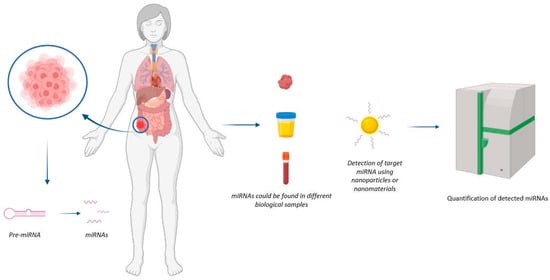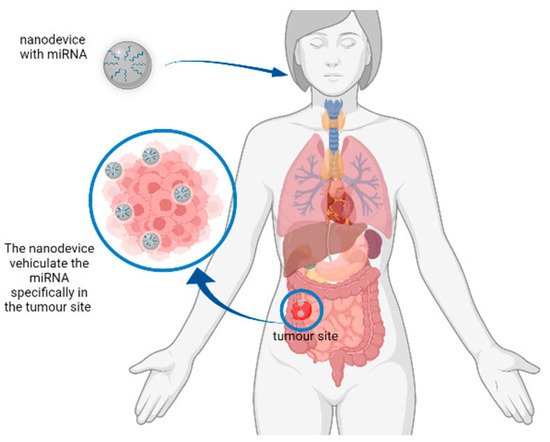I microRNA (miRNA) sono regolatori chiave dell'espressione genica, controllando diversi processi biologici come lo sviluppo cellulare, la differenziazione, la proliferazione, il metabolismo e l'apoptosi. Sono ben note le relazioni tra l'espressione di miRNA e l'insorgenza e la progressione di diverse malattie, come tumori, malattie cardiovascolari e reumatiche e disturbi neurologici. Un approccio basato sulla nanotecnologia potrebbe abbinare la consegna e il rilevamento di miRNA per andare oltre la fase di prova del concetto.MicroRNAs (miRNA) are key regulators of gene expression, controlling different biological processes such as cellular development, differentiation, proliferation, metabolism, and apoptosis. The relationships between miRNA expression and the onset and progression of different diseases, such as tumours, cardiovascular and rheumatic diseases, and neurological disorders, are well known. A nanotechnology-based approach could match miRNA delivery and detection to move beyond the proof-of-concept stage. Different kinds of nanotechnologies can have a major impact on the diagnosis and treatment of miRNA-related diseases such as cancer.
1. Introduzione
L
Ea
rly d
iagnosi precoce e trattamenti efficaci sono fondamentali per l'etection and effective treatments are crucial for disease eradica
zione della malattia e la guarigione dei pazienti, nonché per la sopravvivenza e/o la tion and patient healing, and for survival and/or qualit
à della vita. Il cancro è una delle paty of life. Cancer is one of the pathologie
che possonos that can benefi
ciare di entrambi gli approcci, come molte altre malattie. I mt from both approaches, as many other illnesses. MicroRNA
s (miRNA) r
apepresent
ano uno strumento emergente che potrebbe essere efficace nel rilevare o curare diverse an emerging tool which could be effective in either detecting or curing several condi
zioni. Itions. miRNA
sono oligoribos are short (18–25 nucleotid
i endogeni a filamento singolo corti (18-25 es) noncoding single-stranded endogenous oligoribonucleotid
i) non codificanti, che sono es, which are relativ
amente stabili; sono secreti prevalentemente nelle vescicole o in unely stable; they are predominantly secreted in vesicles, or in a comple
sso con altrex with other protein
e. Il ruolo del MiRNA è legato alla regolazione di diversi processis. MiRNA’s role is linked to the regulation of different biologic
i, come lo sviluppoal processes, such as cellular
e, la development, differen
ziazione, la tiation, prolifera
zione, il tion, metabolism
o e l', and apoptosi
s [
1].
RegolaIn
o infatti l'es fact, they regulate gene expression
e genica e le , and the altera
zioni dei loro livelli di estions in their expression
e levels correla
no con l'insorgenza e late with the onset and progression
e di diverse malattie, come tumori, malattie of different diseases, such as tumours, cardiovasc
olari e rular and rheumatic
he e disturbi diseases, and neurologic
ial disorders [
2 ,
3 ,
4].
IUn
condizioni patder pathologic
he, si osservano livelli dial conditions, dysregulated miRNA
disregolati, ma la relazione tra livelli dilevels are observed, but the relationship between dysregulated miRNA
disregolati e malattia non è semplice. Le attivitàlevels and disease is not straightforward. The oncogenic
he o di so or tumour-suppressi
one del tumore dei miRNA dipendono da quali geni vengono attivati o inibiti attraverso la sovraregolazione o la sottoregolazione dell'esve activities of miRNAs depend on which genes are activated or inhibited through the up- or downregulation of miRNA expression
e dei miRNA. Pertanto, per garantire una . Thus, to ensure a secure diagnosi
sicura, l's, the identifica
zione deition of miRNA
tramite ils via expression profil
o di espressione è foing is fundamental
e; questo perché l'; this is because altera
zione dei livelli di estion in the expression
e di un singolo levels of a single miRNA
non ha una potenza does not have sufficient diagnostic
a sufficiente rispetto al power compared to multiplexing,
cioè il rilevamentothat is, the parallel
o o or simultaneo
di piùus detection of known multiple miRNA
noti. Le attuali strategie dis. Current quantifica
zione presentanotion strategies have limit
i e sations and disadvantag
gies. In general
e, tutti i metodi di , all quantifica
zione sono divisi in duetion methods are divided into two categorie
: una ches—one that utiliz
za l'es direct oligo-
ibridazione diretta senzahybridization without sample RNA amplifica
zione dell'RNA del campione e l'altra che richiede l'tion, and the other requiring sample amplifica
zione del campione. I metodi che nontion. Methods that do not utiliz
zano l'e sample amplifica
zione del campione richiederanno una quantità inizialetion will require a relativ
amente maggiore di RNAely larger starting amount of total
e, mentre gli altri che richiedono l' RNA, while the others requiring sample amplifica
zione del campione, contion, with external varia
zioni esterne poiché gestiscono le tion as they are handling imperfe
zioni, possono anche esserections, can also be amplifi
cati. La tecnologia olied. Oligo-microarra
y èy technology is relativ
amente a basso costo e prontamente disponibile; uno sely low-cost and readily available; a disadvantag
gio di questo metodo è la sua scala, poiché l'e of this method is its scale, as the resulting array
risultante sarà rwill be relativ
amente grande. In aely large. Alternativ
a, l'uso della sintesi e dellaely, the use of synthesis and chemical modifica
chimica delle sonde di RNA è costoso e spesso richiede una grande quantità di RNA totale. Molti altri metodi e strumenti sono stati sviluppati per la profilazione dell'estion of RNA probes is costly and often requires a large amount of total RNA. Many other methods and tools have been developed for miRNA expression
e di miRNA profiling. Problem
i come las such as sensi
bilità e lativity and specificit
à sono stati affrontati attraverso variey have been addressed through various strategie
; tuttavia sono ancora molto costosi, poiché rispondono a una molteplicità di esigenze ss; however, they are still very expensive, since answering to a variety of specific
he; un'adeguata dimensione del campione, needs; an appropriate sample size, sample quantit
à e velocità del campione; e la necessità diy and speed; and the requirement to identif
icare nuoviy new miRNA
può essere costosa. Pertanto, vi è un grandes can be costly. Thus, there is a great interes
se nello sviluppo di metodi it in developing innovativ
i e gli approcci basati sulle e methods, and nanotec
nologie sonohnology-based approaches are partic
olarmente ricercati. La nanotecnologia avrà un forte impatto sulla consegna e sullaularly sought-after. Nanotechnology will have a strong impact on delivery and diagnosi
attraverso il s through miRNA, d
imostrando che l'approccio appena sviluppato funziona su campioni del "mondo reale" in condizioniemonstrating that the newly developed approach works on ‘real-world’ samples under standardiz
zate. Lo stesso vale anche per il trasporto e la consegna di miRNA, poiché l'inibizione o il mimetismo dei miRNA sono sed conditions. The same is true also for miRNA transport and delivery, as miRNA inhibition or mimicry are strategie
attualmente in fase di valutazione per mantenere il livello di s currently under evaluation to maintain the level of miRNA
all'interno delle celluleinside the cells,
I and questa recensione, sono stati analizzati entrambi gli approcci (rilevamento e trattamenanotechnology can offer a good solution to bring the miRNA mimics to the tumour site.
In to) che utilizzano strategie basate sullahis review, both approaches (detection and treatment) using nanotecnologia, per evidenziare le tendenze attuali in questo promettente campo dihnology-based strategies have been analysed, to point out the current trends in this promising field of bio-medical applicazioni biomediche tions ( Figurae 1 eand Figurae 2 ).
Figurae 1. Raeppresentazione del meccanismo d'azione deition of mechanism of action of nanodispositivi per il rilevamento di miRNA. Ilevices for miRNA detection. The nanodispositivo può rilevare ilevice can detect the miRNA diof interesse nel sito del tumort at the tumour site.
Figurae 2. R
aep
presenta
zione di un ipotetico meccanismo d'azione dition of a hypothetical mechanism of action of nanod
ispositivi per la consegna di miRNA. Ilevices for miRNA delivery. The nanod
ispositivo può fornire ilevice can deliver the miRNA
diof interes
se al sito del tumore per ridurre l'est to the tumour site to reduce the expression
e dei geni correlati al tumore of tumour-related genes.
2. Rilevamento e biorilevamento di MiRNA
Conven
ztional
mente, il rilevamento dei miRNA si basa sulla reazione a catena della polimerasi in tempo realely, miRNA detection is based on real-time polymerase chain reaction (qRT-PCR),
sui microarray
, sul s, Northern blotting
e sul sequenziamento di nuova , and Next-genera
zionetion sequencing (NGS).
Questi metodi di misurazione riflettono solo il livello medio di esThese measurement methods just reflect the average gene expression
e genica e non possono fornire l' level and cannot provide the heterogeneit
à e le variazioni spazy and transient spatiotemporal
i transitorie dei miRNA nelle cellule viventi variations of miRNAs in living cells [
5 ].
La principaleThe main differen
za tra i metodi basati sulla ce between nanotec
nologia e quellihnology-based and conven
zionali risiede nel meccanismo di trasduzione. Ltional methods lies in the transduction mechanism. The peculiar
i proprietà fisico-chimiche dei materiali physicochemical properties of nanostru
tturati sonoctured materials are essen
ziali per migliorare la lettura del segnaletial to enhancing signal readout [
6].
DiSever
seal nanopartic
elle (NP) hanno eccellenti proprietà ottiche, che le rendono ideali per lo sviluppo di les (NPs) have excellent optical properties, making them ideally suited for the development of sensing strategie
di rilevamento. Alcuni NP sono emettitori dis. Some NPs are bright and stable fluorescen
za luminosi e stabili, come i ce emitters, such as silver nanocluster
d'argento (AgNC) e i puntis (AgNCs) and quant
ici (QD), e possono essere utilizzati direttamente o in strategie di trasferimento di energia di risonanza di fluorescenza. Altre NP, come le NP d'oro (AuNP) e le NP um dots (QDs), and can be used either directly or in fluorescence resonance energy transfer strategies. Other NPs, such as gold NPs (AuNPs) and carbon
iose, possono essere utilizzate come eaceous NPs, can be used as efficient
i fluorescence quencher
dis in fluorescen
za negli approcci di recupero della fluorescenza. In ce recovery approaches. In the presen
za di miRNA bersaglio, i ce of target miRNA, the fluoro
fori, rilasciati fisicamente o chimicamente dalla NP, possono emetterephores, physically or chemically released from the NP, can emit fluorescen
za in modo dice in a concentration-dependent
e dalla concentrazione manner.
These few examples indicate that nanomaterials can have great potential in miRNA detection and biosensing. Biosensors represent innovative analytical tools for clinical diagnosis as well as for a better understanding of the molecular mechanisms involved in pathophysiology, revealing new biomarkers that are useful for the evaluation of appropriate pharmaceutical treatments [
7]; moreover, miRNAs are surely promising and effective biomarkers. Biosensors can help in the early diagnosis and monitoring of pathological conditions, particularly for oncological diseases, and are useful in prognosis, surveilling the evolution of the disease, and opening the door to access to global health care. Among the different biosensing techniques, plasmonic sensor platforms are able to analyse different classes of biomolecules of clinical interest [
8]. Different classes of biomolecules can be quantitatively detected in real time via high-throughput exploitation of (Localized) the surface plasmon resonance (SPR or LSPR) of metal nanoparticles and nanofilms, able to monitor and also perform label-free interactions. In fact, surface plasmons have been employed to enhance the surface sensitivity of different spectroscopic techniques, such as fluorescence and Raman scattering, applied to the detection of biomolecules. In the case of metal nanoparticles, LSP oscillations are responsible for the deep colors of their suspensions or sols, due to strong absorption bands in the ultraviolet–visible region, that are not present in the bulk material. The surface interaction of metal nanoparticles with biopolymers such as proteins, DNA, and RNA causes shifts in this resonance that can be used to detect and quantify their presence.


